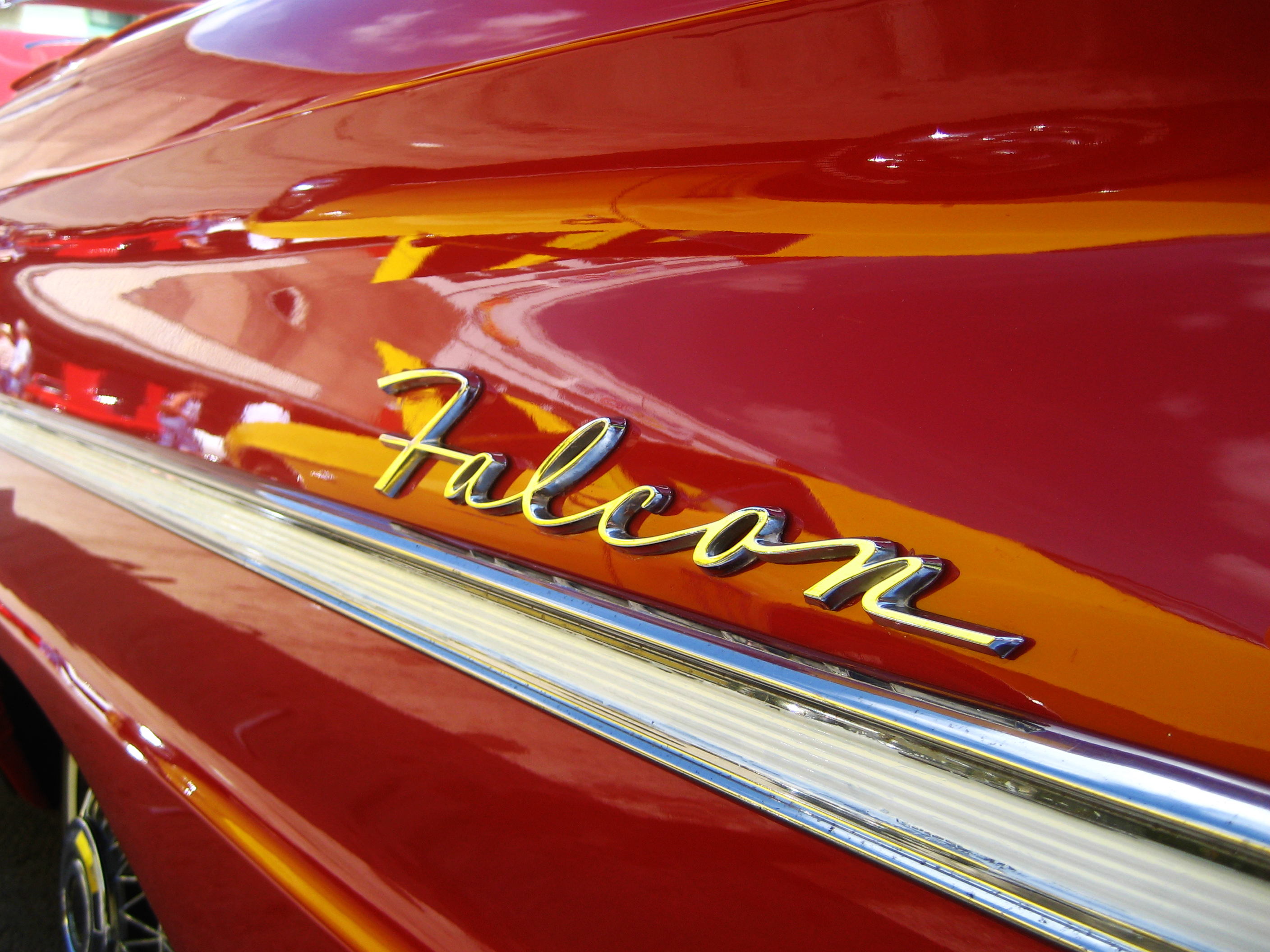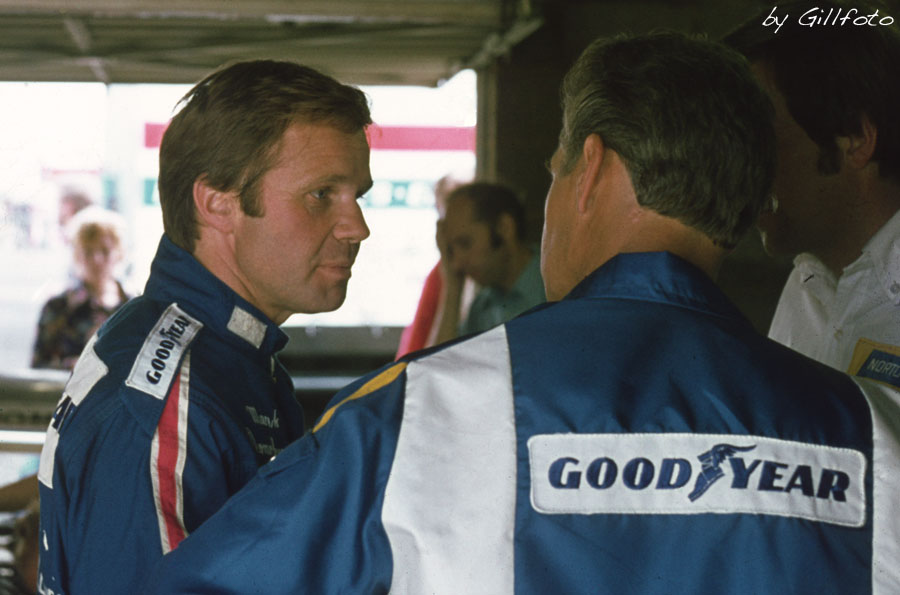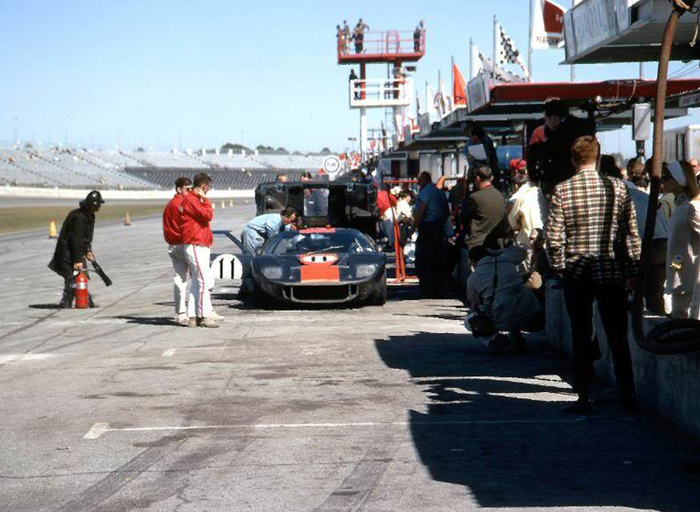|
1960s In Motorsport
This article documents the events that occurred in motorsports in the 1960s. United States *The Grand National continues to see popularity as muscle cars come into popularity. *Due to the rise of pony cars such as the Ford Mustang, a new series is created known as the Trans-American Sedan Championship, featuring all pony cars with a maximum five liter (302ci) displacement limit. *Also established is a prototype-based Canadian-American Challenge Cup *The Indianapolis 500 becomes an independent race, separating from Formula One. The United States Grand Prix replaces it, being held at Watkins Glen. *The United States is heavily competitive in the World Sports Car Championship due to the innovative Corvette Stingray, Shelby Cobra, and Ford GT40. The GT40 would prove to be a major success in the 24 Hours of Le Mans, winning it four consecutive times. *Racing legend Jim Hall establishes Chaparral Cars, a highly innovative team in the Can Am Series. *Racing legend Caroll Shelb ... [...More Info...] [...Related Items...] OR: [Wikipedia] [Google] [Baidu] |
1950s In Motorsport
This article documents the status of motorsports in the 1950s. United States *Due to the rising popularity of stock car racing, the new Strictly Stock Series is established as the Grand National. The series becomes phenomenally popular, and attracts numerous domestic manufacturers. *The Chevrolet Corvette and Ford Thunderbird become the first true American sports cars. Late in the decade, the Corvette would adopt a V8 engine and become heavily competitive in endurance racing. *The Indianapolis 500 is added to the new grand prix schedule. It is later replaced with a United States Grand Prix in 1959. *Racing legend Phil Hill debuts in 1958. *The SCCA National Sports Car Championship was first contested in 1951, America's first championship for sports cars. *The Twelve Hours of Sebring is first held * NASCAR legend Richard Petty debuts *Debut of racing legend A. J. Foyt in IndyCar *The Hudson Hornet is dominant in NASCAR *The National Hot Rod Association is founded as a pro ... [...More Info...] [...Related Items...] OR: [Wikipedia] [Google] [Baidu] |
Chaparral Cars
Chaparral Cars was a pioneering American automobile racing team and race car developer that engineered, built, and raced cars from 1963 through 1970. Founded in 1962 by American Formula One racers Hap Sharp and Jim Hall, it was named after the roadrunner, a fast-running ground cuckoo also known as a ''chaparral bird''. Background Dick Troutman and Tom Barnes were builders of the original Chaparral race cars (later referred to as Chaparral 1). Jim Hall purchased two Chaparral 1s to race. When Hall and Sharp began building their own cars, they asked Troutman and Barnes if they could continue to use the Chaparral name. That is why the Hall/Sharp cars are all named Chaparral 2s (models 2A through 2J for sports cars/CanAm cars, and the 2K which was the 1979–1982 Indycar). Despite winning the Indianapolis 500 in 1980, they left motor racing in 1982. Chaparral cars also featured in the SCCA/ CASC Can-Am series and Endurance racing. Jim Hall was a leader in the innovation and des ... [...More Info...] [...Related Items...] OR: [Wikipedia] [Google] [Baidu] |
Ford Torino
The Ford Torino is an automobile that was produced by Ford for the North American market between 1968 and 1976. It was a competitor in the intermediate market segment. The car was named after the city of Turin (''Torino'', in Italian), considered "the Italian Detroit". The Torino was initially an upscale variation of the intermediate sized Ford Fairlane with a similar approach to the Ford LTD being the upscale version of the Ford Galaxie. Beginning in the 1968 model year the intermediate Ford line consisted of Fairlane and Torino models. The ''Fairlane'' name was utilized for the lower trim level models while the upscale models were called ''Torino''. During this time, the Torino was considered a subseries to the Fairlane. By 1970 ''Torino'' had become the primary name for Ford's intermediate, and the Fairlane was now a subseries of the Torino. In 1971 the ''Fairlane'' name was dropped altogether, and all Ford intermediates were called ''Torino''. This name was one of several ... [...More Info...] [...Related Items...] OR: [Wikipedia] [Google] [Baidu] |
Ford Falcon (North America)
The Ford Falcon is a model line of cars that was produced by Ford from the 1960 to 1970 model years. The first compact car marketed by the American Big Three automobile manufacturers (though antedated by the Rambler American), the Falcon was the third car line introduced by Ford, following the full-sized Ford and the Ford Thunderbird. In contrast to its competitors, the Falcon was developed as a scaled-down version of the full-size Ford Galaxie sedan. Through its production, the Falcon was offered in the same body styles as its full-sized Galaxie counterpart, including two-door and four-door sedans, two-door hardtops and convertibles, two-door and four-door station wagons (the former, serving as a basis of the final Ford sedan delivery), and coupe utility pickups (serving as the basis of the Ford Ranchero). During its production, the Falcon served as the basis for multiple Ford vehicle lines, including the first generations of the Ford Mustang pony car and the Ford Econoline ... [...More Info...] [...Related Items...] OR: [Wikipedia] [Google] [Baidu] |
Plymouth Superbird
The Plymouth Superbird is a highly modified, short-lived version of the Plymouth Road Runner with applied graphic images as well as a distinctive horn sound both referencing the popular ''Looney Tunes'' cartoon character the Road Runner. It was the factory's follow-up stock car racing design, for the 1970 season, to the Dodge Charger Daytona of 1969, and incorporated many engineering changes and modifications (both minor and major) garnered from the Daytona's season in competition. The car's primary rivals were the Ford Torino Talladega and Mercury Cyclone, a direct response to the Mopar aero car. It has also been speculated that a motivating factor in the production of the car was to lure Richard Petty back to Plymouth. Both of the Mopar aero cars famously featured a protruding, aerodynamic nosecone, a high-mounted rear wing and, unique to the Superbird, a horn mimicking the Road Runner's signature " beep, beep." Superbirds equipped with the top-of-the-line Hemi engine with ... [...More Info...] [...Related Items...] OR: [Wikipedia] [Google] [Baidu] |
Dodge Charger Daytona
Dodge produced three separate models with the name Dodge Charger Daytona, all of which were modified Dodge Chargers. The name was taken from Daytona Beach, Florida, which was an early center for auto racing and still hosts the Daytona 500, NASCAR's premier event. The original Dodge Charger Daytona was designed to beat the competition in NASCAR racing. It was the first NASCAR vehicle to reach 200 miles per hour, which was a major milestone at the time. The first use of the 'Daytona' name for a car was on a version of the Studebaker Lark. The Daytona was the performance model of the compact Lark, and it was produced during the 1960s. 1969 With the racing failure of the previous limited edition 1968 Dodge Charger 500 in NASCAR and Plymouth's superstar Richard Petty leaving them for Ford, the 1969 Dodge Charger Daytona was created. It was intended to be a high-performance, limited-edition version of the Dodge Charger produced in the summer of 1969 for the sole purpose of winning ... [...More Info...] [...Related Items...] OR: [Wikipedia] [Google] [Baidu] |
Talladega Superspeedway
Talladega Superspeedway, nicknamed “'Dega”, and formerly named Alabama International Motor Speedway (AIMS) from 1969 to 1989, is a motorsports complex located north of Talladega, Alabama. It is located on the former Anniston Air Force Base in the small city of Lincoln, Alabama, Lincoln. A tri-oval, the track was constructed in 1969 by the International Speedway Corporation, a business controlled by the France Family. , the track hosts the NASCAR Cup Series, NASCAR Xfinity Series, NASCAR Camping World Truck Series, and ARCA Menards Series. Talladega is the longest NASCAR oval, with a length of , compared to the Daytona International Speedway, which is long. The total peak capacity of Talladega is around 175,000 spectators, with the main grandstand capacity being about 80,000. History During the 1960s, William France, Sr., William "Bill" France, Sr. wanted to build a track faster and longer than his Daytona International Speedway. After failed attempts to reason with local ... [...More Info...] [...Related Items...] OR: [Wikipedia] [Google] [Baidu] |
Mario Andretti
Mario Gabriele Andretti (born February 28, 1940) is an Italian-born American former racing driver. One of the most successful drivers in the history of motorsports, Andretti is one of only two drivers to have won races in Formula One, IndyCar, the World Sportscar Championship, and NASCAR (the other being Dan Gurney). He has also won races in midget car racing and sprint car racing. During his career, Andretti won the 1978 Formula One World Championship, four IndyCar titles (three under USAC sanctioning, and one in CART), and IROC VI. To date, he remains the only driver ever to win the Indianapolis 500 ( 1969), Daytona 500 ( 1967) and the Formula One World Championship, and, along with Juan Pablo Montoya, the only driver to have won a race in the NASCAR Cup Series, Formula One, and an Indianapolis 500. As of 2021, Andretti's victory at the 1978 Dutch Grand Prix is the last Formula One win by an American driver. Andretti had 109 career wins on major circuits. Andretti had a long ... [...More Info...] [...Related Items...] OR: [Wikipedia] [Google] [Baidu] |
Mark Donohue
Mark Neary Donohue Jr. (March 18, 1937 – August 19, 1975), nicknamed "Captain Nice," and later "Dark Monohue," was an American race car driver and engineer known for his ability to set up his own race car as well as driving it to victories. Donohue is probably best known as the driver of the 1500+ bhp "Can-Am Killer" Porsche 917-30 and as the winner of the Indianapolis 500 in 1972. Cars that Donohue raced include: AMC Javelin, AMC Matador, Chevrolet Camaro, Eagle-Offy, Elva Courier, Ford GT40 MK IV, Ferrari 250LM, Ferrari 512, Lola T70, Lola T330, Lotus 20, McLaren M16, Porsche 911, Porsche 917/10, Porsche 917/30, Shelby Cobra, and Shelby Mustang GT350R. Early life Born in Haddon Township, New Jersey, Donohue grew up in Summit, graduated from the Pingry School in Hillside, and entered Brown University in Providence, Rhode Island. At the age of twenty-two, while a senior at Brown, Donohue began racing his 1957 Corvette. He won the first event he entered, a hillclimb in Belk ... [...More Info...] [...Related Items...] OR: [Wikipedia] [Google] [Baidu] |
Pontiac GTO
The Pontiac GTO is an automobile that was manufactured by American automaker Pontiac from 1963 to 1974 for the 1964 to 1974 model years, and by GM's subsidiary Holden in Australia for the 2004 to 2006 model years. The first generation of the GTO is credited as popularizing the muscle car market segment in the 1960s. The Pontiac GTO is considered by some to have started the trend with all four domestic automakers offering a variety of competing models. For the 1964 and 1965 model years, the GTO was an optional package on the intermediate-sized Pontiac Lemans. The 1964 GTO vehicle identification number (VIN) started with 22, while the 1965 GTO VIN started with 237. The GTO became a separate model from 1966 to 1971 (VIN 242...). It became an optional package again for the 1972 and 1973 intermediate LeMans. For 1974, the GTO was an optional trim package on the compact-sized Ventura. The GTO was selected as the ''Motor Trend'' Car of the Year in 1968. The GTO model was revived ... [...More Info...] [...Related Items...] OR: [Wikipedia] [Google] [Baidu] |
24 Hours Of Daytona
The 24 Hours of Daytona, also known as the Rolex 24 At Daytona for sponsorship reasons, is a 24-hour sports car endurance race held annually at Daytona International Speedway in Daytona Beach, Florida. It is run on the Sports Car Course layout, a combined road course that uses most of the tri-oval plus an infield road course. Held on the last weekend of January or first weekend of February as part of Speedweeks, it is the first major automobile race of the year in North America. The race is sanctioned by IMSA and is the first race of the season for the IMSA SportsCar Championship. The race has borne the names of several sponsors over the years. Since 1992, the Rolex Watch Company has been the title sponsor of the race, replacing Sunbank, which replaced Pepsi in 1984. Winning drivers of all classes receive a Rolex Daytona watch. The race has been known historically as a leg of the informal Triple Crown of endurance racing. Beginnings Shortly after the track opened, on Ap ... [...More Info...] [...Related Items...] OR: [Wikipedia] [Google] [Baidu] |
United States Road Racing Championship
The United States Road Racing Championship (USRRC) was created by the Sports Car Club of America in 1962. It was the first SCCA series for professional racing drivers. SCCA Executive Director John Bishop helped to create the series to recover races that had been taken by rival USAC Road Racing Championship, a championship that folded after the 1962 season. For its first three seasons, the series featured both open-topped sports cars and GT cars. Ford and Porsche dominated the Over- and Under-2 Liter classes, respectively. The USRRC ran from 1963 until 1968 when it was abandoned in favor of the more successful Can-Am series, which was also run by the SCCA. In 1998 the USRRC name was revived by the SCCA as an alternative to the IMSA GT Championship, and revived the Can-Am name for its top class. For 1999 the series reached an agreement with the International Sports Racing Series in Europe, in which the two series would share the same rules for prototypes. Entries for the se ... [...More Info...] [...Related Items...] OR: [Wikipedia] [Google] [Baidu] |
_at_New_Canaan%2C_front_right.jpg)

.jpg)


.jpg)
